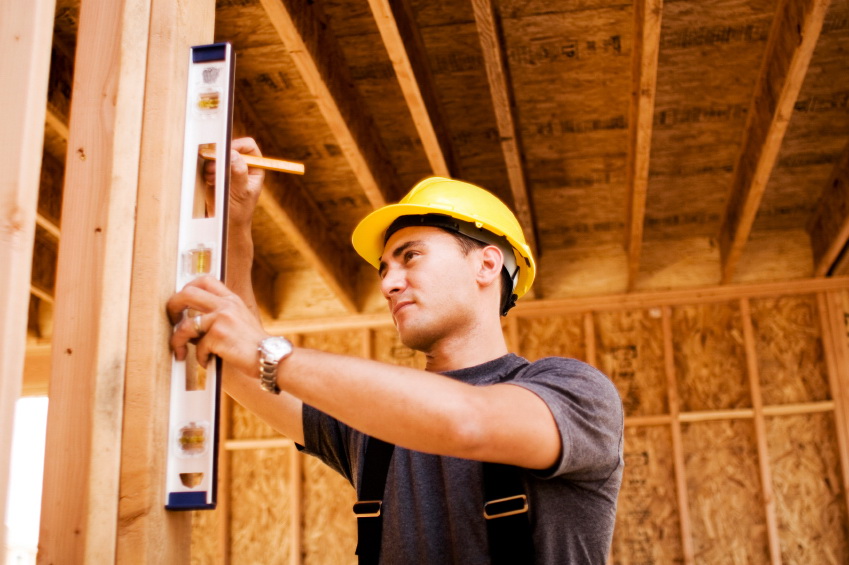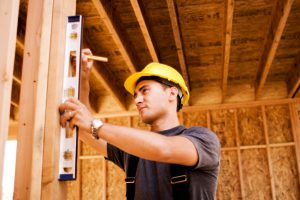
Plywood and OSB paneling expands and contracts as it adjusts to the moisture content of the building site. Unrestrained by fastening and framing, panels can move an average of 1/8 inch as they acclimatize. Correct spacing between panels when framing will absorb most of this expansion, but where insufficient spacing or dense nailing patterns prevent movement, a net expansion of floor and roofing decks may result in unevenness or buckling.
inch as they acclimatize. Correct spacing between panels when framing will absorb most of this expansion, but where insufficient spacing or dense nailing patterns prevent movement, a net expansion of floor and roofing decks may result in unevenness or buckling.
The cumulative effects of panel expansion can also result in walls and floors that aren’t straight and door and window openings may be affected in both interior and exterior walls. The resultant gaps in the building envelope compromise energy efficiency. Remember; “Energy Savings start with the Framing™.”
Prevent Buckling
When adequate spacing between panels is not present, buckling may occur in walls and roofs and may also result in uneven flooring or roofing. Panel spacing of 1/8-inch is recommended and, in most cases, required to provide installers a means of minimizing the potential for panel buckling.
Although buckling will not adversely affect panel performance, it has a negative aesthetic impact and can cause related problems. While proper panel spacing should be a part of every build, there are certain circumstances under which the risk of buckling increases. According to the APA document X480C, these include:
- Shear wall or diaphragm applications with edge nail spacing 4 inches o.c. or closer
- Use of 3-ply plywood panels with a face grain parallel to supports (i.e. walls)
- Panels installed within a few days of their manufacture
- Extended rainy weather where panels may become saturated with water
- Panels that have not been allowed to acclimatize properly
Under these conditions, the 1/8-inch panel spacing may not suffice. Buckling can be minimized by allowing panels (especially those which have just been manufactured) to acclimate to their new conditions. Store panels on-site under the conditions outlined in the APA guidelines prior to the build.
If there is no time to allow for acclimation, consider increasing panel spacing to ¼ inch. In instances where nail spacing is 4 inches o.c. or closer, the panels will not be able to expand, rendering the 1/8-inch panel spacing ineffective in preventing buckling. Where possible, framers should opt for 12 or 24 o.c. nail spacing initially and then leave the panels to absorb moisture and expand. Once the panels are acclimatized, the nailing patterns must be completed or you will not have the structural properties needed.
Preventing net expansion in larger buildings
Structures longer than 80 L/F must have expansion joints built into them to allow for expansion and contraction. The APA document U425 indicates that with flooring, gaps of ¾ inch must be created between panels at the designated joint intervals. Nailing and fastening of panel ends can be left until the wood has acclimatized to allow for expansion. With roofs, the APA recommends sheathing large roofs in 80-foot sections… “omitting a roof sheathing panel (in each course of sheathing) between sections. This provides effective temporary sheathing joints.” Once the panels have acclimatized, the missing panels can be trimmed to size and installed.
Wood grain directions
Make sure plywood is installed with the grain in the right direction. When plywood is incorrectly installed it can lead to soft spots, squeaky floors, buckling or (worst case scenario) structural failure. Plywood and OSB sub-flooring must be installed with surface grain at right angles to the joists. Plywood or OSB roof sheathing must be installed with surface grain at right angles to the roof framing. Don’t install panels parallel to the supports. Span ratings are based on the proper installation of panels, so ensure that yours are installed according to your local building code, design professional’s instructions and the manufacturer’s installation instructions.
Always ensure the supports (joists and roof framing) are level and straight and take corrective action before installing any panels. Installing your plywood and OSB wood panels with sufficient panel spacing and with the grain oriented in the right direction will ensure perfect walls and roofs, an efficient building envelope and even flooring that doesn’t squeak.
